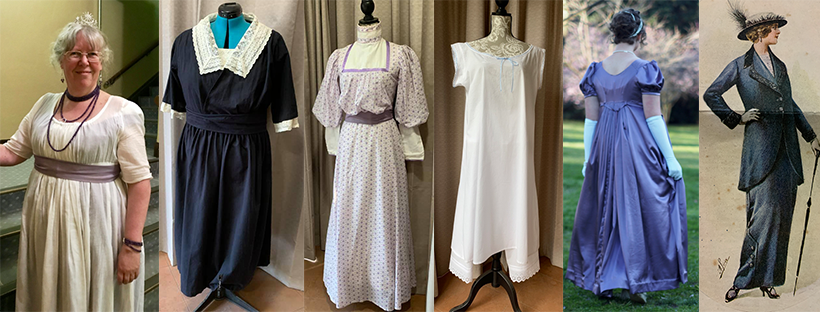A project from 2018, re-made 2019
The centenary of the Armistice that ended hostilities in the First World War was on November 11th, 2018. Our local Folk Museum mounted a commemorative display, Sorrow, Celebration and Social Change. My contribution to the display included a small curated selection from the museum’s collection showing the rapid changes in fashion during the few years of the war, and two presentations (one at the opening, the other in February 2019) discussing and illustrating those changes and their reflection of the changing role of women in society.
In planning for the exhibition and presentation, I wanted to make a dress of a style that might have been worn by a middle-aged lady in my town at the time. November is almost summer here in Australia, and images of fashions took at least three months to travel from the northern hemisphere.
One of my inspiration images (found on Tumblr) was this dress from the Norsk Folkemuseum:

This black dress from the Museum’s collection was also inspiration, particularly for construction methods:


As I didn’t have silk for my dress, or chiffon, or time to do embroidery, I styled my dress loosely based on the Norwegian one, but with a simpler vestee due to a shortage of time.
Like the museum dress, my dress was constructed with an underbodice/lining which closes in centre-front with hooks and eyes. (My dressmaker’s model is smaller than me, so I don’t use it for fitting.)

The lace vestee was the next step. I used a cotton blend lace fabric, lined with cotton lawn.

I attached the lace vestee to on side of the under-bodice and it fastens over the other side with snaps.
I didn’t use a specific pattern for the dress, but instead adapted from a basic fitted bodice in keeping with pattern shapes from period patterns. The bodice has a wrap-front, with soft pleats at shoulder and waist. The fabric is a black slightly-textured cotton fabric I’ve had in my stash for years; the underbodice is black lawn, likewise from stash.

The bodice was sewn to the gathered skirt at the back and on one side front. The skirt was gathered on to a twill band and closes at the side with a bar hook and snaps, and the other bodice front closes over the top with snaps. I made a wide self-fabric sash which closes at the side with snaps.
Unfortunately I did not get the lace collar made and attached before the Armistice Centenary service, and the official opening of the Folk Museum display after it. However, the dress was otherwise finished and so I wore it without the collar. (I did have black gloves as well, but had to take them off to use the iPhone, and in the rush didn’t put them back on again. So please excuse the naked arms outdoors!)


In January I gave a talk at the Museum about WW1 fashions and how they both reflected and enabled the changing role of women – so I made sure I added the collar to the dress before that event!
I didn’t have and couldn’t find locally a lace collar of a suitable shape, so I made one using the mostly-cotton lace fabric I used for the vestee, with a wide border of cotton lace (on the left in the first image) carefully hand-stitched on to it.



A couple of days after this photo was taken, I ended up in hospital with gall bladder issues, and since then have lost a fair amount of weight. I wore this dress again in late April, to give a presentation at Saumarez Homestead, and had to make considerable alterations for it to fit. I took the skirt off the twill band, regathered it to make the waist measurement several inches smaller; took the bodice back in and altered the wrap front, and then put it all back together.

